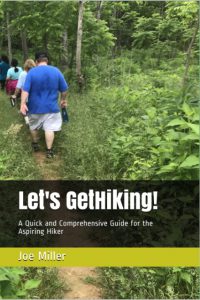This past weekend’s GetBackpacking! trip had the forecast for disaster: high temperatures around 90 under sunny skies. Not the best way to make a favorable first impression, especially to folks unaccustomed to hiking with 35 pounds on their backs. And yet … .
At hike’s end, every person on the trip couldn’t wait for the next hike to begin.
Why?
Because we worked with the heat rather than against it. On the hike in, a 4-mile walk with plenty of climbing exposed to the sun, we stopped at a water crossing, dropped our backs and cooled off in the stream. We took frequent breaks in the shade. We took advantage of the occasional breeze that penetrated the trees. We took our time.
When you see ads for hiking boots or daypacks or hiking clothes, you see pictures of happy people wearing fleece, perhaps a knit hat, framed against the colors of fall and a brilliant blue sky. Just looking at the ad you can tell the temperature is 64 degrees — perfect weather for hiking. Rarely do such ads show someone bathed in sweat and swathed in cobwebs under a milky sky. The summer hiking experience just doesn’t sell. Which is a shame, because there’s so much to experience in summer.
With a few precautions you’ll find it’s not a bad time to be on the trail. Today, as we head into the first official weekend of summer, we share these hot weather hiking tips from our book, “Let’s GetHiking! A Quick and Comprehensive Guide for the Aspiring Hiker.”
Drink up. Rather, drink, drink, drink up. And not just while you’re hiking. A good hydration program is ongoing. For instance, two days before a big hike I make sure to have a water bottle with me at all times. I’m not drinking constantly, but its constant presence reminds me to drink more. On the trail, be sure to have plenty of water with you. Your two main options:
- Camelbak: This is a bladder that straps to your back (it’s inside a daypack); you drink from it through a tube and mouthpiece. Advantage: It’s extremely convenient making it more likely that you’ll drink. (I went through 100 milliliters of water during a two-hour mountain bike race recently; had I used bottles I would have consumed about half that.) Disadvantage: They’re a little more expensive (the basic Camelback is around $50) and because they rest against your back, the water tends to heat up on hot days.
- Fanny pack water bottles: For training purposes, a minimalist fanny pack holding two bottles works well. My favorite is the DoubleShot (available at REI for about $35), which holds your basics (car keys, cell phone, an energy bar or two) and a pair of 21-ounce water bottles. (The bottles slip into the pack at an angle, making them easier to access and less inhibiting to your stride.)
- Tip: Whichever route you go, keep the water cold. For the Camelbak, that could mean loading it up with ice, then topping it off with water; for the water bottles, I like to fill them three quarters full the evening before and stick them in the freezer. Top ‘em off with water before heading out the next day. In both cases you should have tasty water for most of your hike.
The cotton exception. There’s a saying in the outdoor world: Cotton kills. (I know, it’s always seemed like such a friendly fabric.) It’s homicidal appellation comes from the fact that if you sweat in cotton, cotton keeps the wetness close to your body. If its cool to cold out, that wetness can send a dangerous chill through your body. That’s the same reason why cotton isn’t such a bad thing in summer. Your cotton T-shirt gets sweaty wet, it sticks to you, it helps cool your body. Kinda like a big wet body bandana.
Bring extra socks. Along about mile 5 on a hot, humid summer hike you might start hearing squishing with every footstep. Wet feet quickly lead to blisters. Swap out those socks before they cause trouble.
Body Glide. I’ll try to put this delicately: on a hot, sweat-inducing day, parts of your wet body my be in constant contact with your wet clothing. Back and forth, back and forth, back and forth. Before long, you’ve got some serious chaffing going on. Applying a lubricant to your more susceptible body parts can greatly reduce the risk of rubbing yourself raw. A favorite of mine is Body Glide, which works like a roll-on deodorant and does a good job of minimizing friction.
* * *
Let’s GetHiking!
 The 109-page “Let’s GetHiking! A Quick and Comprehensive Guide for the Aspiring Hiker,” covers the basics of getting started on the trail, from what to wear on your first hike to trail etiquette to the benefits of trekking poles. Learn more here.
The 109-page “Let’s GetHiking! A Quick and Comprehensive Guide for the Aspiring Hiker,” covers the basics of getting started on the trail, from what to wear on your first hike to trail etiquette to the benefits of trekking poles. Learn more here.
GetHiking! Southeast Podcast
 This week on the GetHiking! Southeast Podcast: Our 5 Favorite Group Campsites. Give a listen here.
This week on the GetHiking! Southeast Podcast: Our 5 Favorite Group Campsites. Give a listen here.
